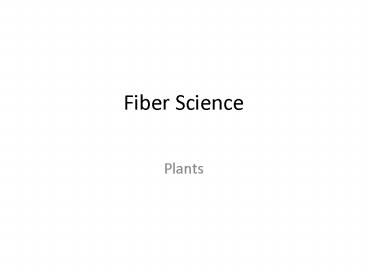Fiber Science - PowerPoint PPT Presentation
Title:
Fiber Science
Description:
Fiber Science Plants Introduction A large part of agriculture is involved with the production of fiber to make clothing and other items such as rugs, tapestry, and ... – PowerPoint PPT presentation
Number of Views:430
Avg rating:3.0/5.0
Title: Fiber Science
1
Fiber Science
- Plants
2
Introduction
- A large part of agriculture is involved with the
production of fiber to make clothing and other
items such as rugs, tapestry, and cloth goods. - Using modern research, development, and
management, agricultural fibers will continue to
be a constantly renewed source of fiber.
3
I. Fiber production trends
- A. Historically, several plants and animals were
used to produce natural fibers. - B. Fibers a long threadlike strand of a
substance - C. Much of the cloth produced today is synthetic
(artificial man-made), and manufactured from
petroleum (i.e. rayon, nylon, and polyester)
4
- 1. Process involves turning petroleum into long
fibers that are then used to make cloth - 2. Synthetic cloth is relatively inexpensive
- 3. Synthetic cloth is durable
- 4. Synthetic cloth is more wrinkle resistant
- 5. Synthetic cloth cannot match agricultural
fiber for comfort
5
- D. Today, natural fibers are becoming more
popular again after declining in popularity when
synthetic cloths were popular. - E. Fiber is produced from both plants and
animals - 1. Plant fibers cotton, flax, hemp, jute,
kenaf (4,000. year old new crop), sisal
(agave plant) - 2. Animal fibers Wool, mohair, camel hair,
alpaca hair, angora rabbit, silk (strongest
of all natural fibers) - F. Four main types of agricultural fibers in the
U.S. cotton, wool, silk, and linen
6
II. Cotton
- A. Historical perspective
- 1. Likely first used in the Nile Valley in
Ancient Egypt - 2. In North America, cotton use pre-dates the
arrival of the European settlers - 3. In approximately 1800, cotton production
made a major impact of agriculture in the U.S. - 4. The invention of the cotton gin (1793 Eli
Whitney) allowed for the removal of the cotton
fibers from the seeds - 5. More varieties could be grown all across the
southern portion of the U.S.
7
- B. Plant characteristics
- 1. Cotton is a shrub-like perennial that
requires a long growing season with warm
temperatures - 2. Cotton is pollinated by bees and other
insects, and as well as being self-pollinated - 3. The fertilized flower forms the seed pod
(known as a boll) that is shaped like a small
football - 4. the cotton fiber forms on the seeds each
fiber is actually a single long plant cell and
most measure near 2 in length when dried and
ready to pick - 5. Seed cotton is called lint
8
- C. Cotton Harvesting
- 1. Cotton is picked with large machines with
rotating finger-like projections that remove the
fiber from the bolls - 2. Cotton pickers replace the manual labor once
required to pick cotton - 3. Big loaf-like bales are made a bale weighs
around 1200 pounds before seeds are removed, and
around 500 after the seeds are removed
9
- D. At the gins
- 1. The seeds are removed
- a. Seeds are a secondary industry
- b. Seeds are pressed to remove the oil
- c. Uses for cottonseed products
- i. Cooking oil
- ii. Cake (leftover seed after oils removed)
is ground into a meal (cottonseed meal) and used
as a protein supplement for ruminants (gossypol
is a substance in the seeds that can kill
simple-stomached animals) - 2. The cotton is cleaned of trash and foreign
material
10
- E. At the mill
- 1. At the mill, bales are mixed to ensure
uniformity - 2. The fibers are run through a carding machine
that separates and aligns the fibers - 3. The fibers are twisted and stretched, and
spun into thread/yarn and are then ready to be
made into fabric
11
- F. Cotton Production
- 1. Number one state is Texas Produces the
most used Upland cotton - 2. Cotton quality distinguished by the staple
(the length of the fiber) - 3. Upland cotton fibers can be used for a wide
range of products including fine clothing as
well as heavy canvas materials - 4. AZ grows both Upland and Pima.
12
III. Flax
- A. Uses of linen dates back to the Stone Age
Linen was used to make fishnets - B. Most countries in the world use linen for
clothing - C. Wide range of uses for linen clothing,
tablecloths, napkins, bedding - D. Linen comes from fibers produced in a plant
called flax - 1. Flax likes to grow Europe and New Zealand
13
- E. Plant characteristic
- 1. Plants grow to a height of about 3 feet and
are then harvested - 2. Linen comes from the fibers (called bast
fibers) that make up the phloem of the plant (the
tubes that transport plant food from the leaves
to other parts of the plants)
14
- F. Plant processing
- 1. The outer layer of woody material must be
dissolved so the fibers can be removed - a. One method involves soaking the stems in
warm water where bacterial action decays the
materials - b. More modern method is using chemicals to
dissolve the outer layer (called retting)
15
- c. After the outer layer is removed, the phloem
fibers are passed through rollers, and the woody
substances connected to the fibers are broken - d. the usable fibers are separated out in a
process called scrutching - e. Collected fibers are then combed out in much
the same way as cotton (called carding) and spun
into yarn
16
- http//www.youtube.com/watch?vAAUQNMldp_Yfeature
related































